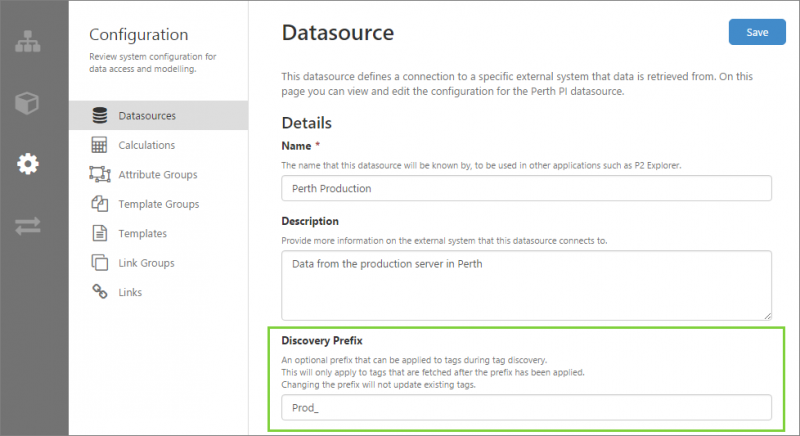ON THIS PAGE:
![]()
Release 4.3.2 adds the full set of calculations previously available in version 2.6.
The Proficy adaptor is also included in this release, as well as an adaptor for retrieving data from P2 Explorer 2.6.
Proficy Adaptor
The Proficy Adaptor connects to the GE Proficy Historian and provides the ability to read and write time series tag data to and from the historian. Note that the adaptor requires as a prerequisite, the Proficy Historian Client Tools that match the version of the historian installed.
The Proficy Adaptor supports versions 4.5 and 5.5 of the Proficy Historian and provides the following configuration parameters:
- Request timeout
- Use Proficy reliable session
- Server certificate validation mode
P2 Server 2.6 Adaptor
The P2 Server 2.6 Adaptor connects to the P2 Explorer 2.6 data dictionary and provides the provides the ability to fetch tag data from datasources already configured in P2 Explorer 2.6. Note that the adaptor requires as a prerequisite, the P2 Explorer 2.6 SDK Client (matching the version of the SDK server you want to connect to).
The P2 Server 2.6 Adaptor provides following configuration parameters:
- Included datasources
- Excluded datasources
- Configured portal protocol
Tag Discovery Prefix
In v4.3.2 tags can be assigned a prefix as they are fetched from a tag datasource. This can be configured in P2 Server Management Studio, when configuring the datasource.
The prefix is optional and will only apply to tags that are fetched after the prefix has been specified. Changing the prefix will not update existing tags, but will be added to new tags that are fetched from that datasource.
Calculations
All calculations previously available in P2 Explorer 2.6 are now available in P2 Server 4.3.2.
Most of the functions retain the same name and syntax, but some have been renamed or changed slightly. The summary of changes is as follows:
| v2.6 | v4.3 |
| ACCUM | Renamed to Sum_Sampled |
| AVG | Renamed to Average |
| HIST_AVERAGE | Renamed to Average_Sampled |
| HIST_CONTINUOUSMAX | Renamed to ContinuousMax_Sampled |
| Hist_ContinuousMin | Renamed to ContinuousMin_Sampled |
| HIST_MAX | Renamed to Max_Sampled |
| HIST_Min | Renamed to Min_Sampled |
| HIST_TIMEWEIGHTEDAVERAGE | Renamed to TimeWeightedAverage_Sampled |
| INTEGRAL | Renamed to SampledIntegral |
| MOD | Replaced by the % operator. |
| NUMSAMPLES | Renamed to Count_Sampled. |
| POWER | Replaced by the ** operator. |
| VALUEAT | Renamed to ValueAt_Sampled. |
Syntax changes
- Use of brackets
In v2.6, if a function did not take any parameters, it could be called without brackets.
However in v4.3.2, all function calls must use brackets. Only keywords can be used without the brackets. Available keywords are:E, ENTITY, FALSE, Log10E, Log2E, NULL, PI, SYSTEMTIME, TRUE.
- Data types
In v2.6 all data was either a string or a double. v4.3.2 has more data types available. A printable “cheat sheet” is available in the Explorer Help Center, showing how expressions containing various data types will resolve using the Calculation Engine. - Sampling()
In v2.6, the SAMPLING() function calls accepted an empty string or a single space for the sample method if the sample method was not going to be changed.
In v4.3.2, an empty string cannot be used. Instead, you should use param[sampleMethod] within the expression, which will look up the current sample method being used. Examples include:SAMPLING(EXPR, param[sampleMethod], 3600)
SAMPLING(EXPR, param[sampleMethod], {du’00:01:00:00})
SAMPLING(EXPR, “LastKnownValue”, param[sampleInterval])
Time Zones
Two new time zone settings have been added to the configuration utility: CalendarTimeZone and ProductionTimeZone.
- CalendarTimeZone can be overridden inside a calculation.
- ProductionTimeZone will not be able to be overridden.
Note that converting time between local time and UTC is still the responsibility of the consuming application. We recommend the use of a time zone picker to control this conversion, which will be important in order to choose how to view production data across time zones.
